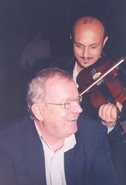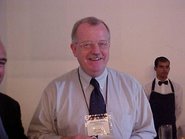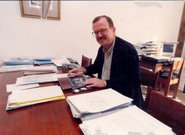 "Yes we support MSDs but we also know that they are not the panacea. I wonder if we should not add somewhere a ‘critical’ note, a reference to the challenges to MSDs to avoid being seen as overly optimistic." Says my client. We are making a video about a multi-stakeholder dialogue for a major policy change that affects a whole sector of society and even beyond. Such changes need some form of MSD. There are many different forms, ranging from one- or two-way information campaigns to joint policy planning and formulation exercises. A well tailored and managed MSD always helps, but no MSD can take over role of the government. In a policy process the decisions on technical, legal and economic measures are taken by the government. They are the different parts of the engine of the policy making. The MSD only provides the oil that makes that engine work.
"Yes we support MSDs but we also know that they are not the panacea. I wonder if we should not add somewhere a ‘critical’ note, a reference to the challenges to MSDs to avoid being seen as overly optimistic." Says my client. We are making a video about a multi-stakeholder dialogue for a major policy change that affects a whole sector of society and even beyond. Such changes need some form of MSD. There are many different forms, ranging from one- or two-way information campaigns to joint policy planning and formulation exercises. A well tailored and managed MSD always helps, but no MSD can take over role of the government. In a policy process the decisions on technical, legal and economic measures are taken by the government. They are the different parts of the engine of the policy making. The MSD only provides the oil that makes that engine work.
Saturday, 18 July 2009
Multi-stakeholder Dialogue: a panacea?
 "Yes we support MSDs but we also know that they are not the panacea. I wonder if we should not add somewhere a ‘critical’ note, a reference to the challenges to MSDs to avoid being seen as overly optimistic." Says my client. We are making a video about a multi-stakeholder dialogue for a major policy change that affects a whole sector of society and even beyond. Such changes need some form of MSD. There are many different forms, ranging from one- or two-way information campaigns to joint policy planning and formulation exercises. A well tailored and managed MSD always helps, but no MSD can take over role of the government. In a policy process the decisions on technical, legal and economic measures are taken by the government. They are the different parts of the engine of the policy making. The MSD only provides the oil that makes that engine work.
"Yes we support MSDs but we also know that they are not the panacea. I wonder if we should not add somewhere a ‘critical’ note, a reference to the challenges to MSDs to avoid being seen as overly optimistic." Says my client. We are making a video about a multi-stakeholder dialogue for a major policy change that affects a whole sector of society and even beyond. Such changes need some form of MSD. There are many different forms, ranging from one- or two-way information campaigns to joint policy planning and formulation exercises. A well tailored and managed MSD always helps, but no MSD can take over role of the government. In a policy process the decisions on technical, legal and economic measures are taken by the government. They are the different parts of the engine of the policy making. The MSD only provides the oil that makes that engine work.
Monday, 29 June 2009
Presentation: target groups and objectives
 What does it take to do a good presentation during a conference? As part of my job to evaluate a multi-country project, my client takes me to a two-day Chatham House conference. His project is presented in the very last timeslot. Afterwards he is worried what the donors may think. He asks my opinion. My reaction: the good thing was to have a professional facilitator with a media back ground, short introductions from different countries, a panel discussion that included the donors and voting with a voting machine for the audience (200 participants). Form was OK, but the content can be improved a next time when you brief speakers to only make one point: lessons learned that are of interest to donors and participants in the international discourse. Even for a conference presentation: be clear on target groups and the KAP objectives for each of them.
What does it take to do a good presentation during a conference? As part of my job to evaluate a multi-country project, my client takes me to a two-day Chatham House conference. His project is presented in the very last timeslot. Afterwards he is worried what the donors may think. He asks my opinion. My reaction: the good thing was to have a professional facilitator with a media back ground, short introductions from different countries, a panel discussion that included the donors and voting with a voting machine for the audience (200 participants). Form was OK, but the content can be improved a next time when you brief speakers to only make one point: lessons learned that are of interest to donors and participants in the international discourse. Even for a conference presentation: be clear on target groups and the KAP objectives for each of them.
Communication strategy in a simple drawing
 A communication strategy basically focuses on the most effective way to realize the objectives to change, knowledge, attitudes, skills and practices. In Public participation in the conservation of the Sava River floodplains you find a useful educational graph positioning the communication strategy in the project.
A communication strategy basically focuses on the most effective way to realize the objectives to change, knowledge, attitudes, skills and practices. In Public participation in the conservation of the Sava River floodplains you find a useful educational graph positioning the communication strategy in the project.
Monday, 1 June 2009
The new face of Protected Areas
 During the joint meeting of two IUCN Commissions (WCPA and CEC) a few weeks ago in Ecuador, we discussed the need to (re)brand protected areas. WCPA experts approached branding from the science perspective. IUCN had commissioned a study on the values of protected areas (PA) and my WCPA colleagues already came up with some slogans for us to comment on or to improve: “Benefits beyond boundaries”; “Parcs for life”; “A convenient solution to an inconvenient truth”. It almost made me also jump to conclusions. “Protected Areas: powering security, health, learning and employment” - crossed my mind. But from the communication perspective more homework needs to be done, before we talk slogans. We have to answer questions such as how do PA contribute to basic human needs; who are the clients; what really is the product or services; how do we position PA in the market; what are the core brand values etc. So I bit my tongue. We agreed that in July some CEC experts will look at the results of the WCPA study and start asking branding questions. I look forward to it.
During the joint meeting of two IUCN Commissions (WCPA and CEC) a few weeks ago in Ecuador, we discussed the need to (re)brand protected areas. WCPA experts approached branding from the science perspective. IUCN had commissioned a study on the values of protected areas (PA) and my WCPA colleagues already came up with some slogans for us to comment on or to improve: “Benefits beyond boundaries”; “Parcs for life”; “A convenient solution to an inconvenient truth”. It almost made me also jump to conclusions. “Protected Areas: powering security, health, learning and employment” - crossed my mind. But from the communication perspective more homework needs to be done, before we talk slogans. We have to answer questions such as how do PA contribute to basic human needs; who are the clients; what really is the product or services; how do we position PA in the market; what are the core brand values etc. So I bit my tongue. We agreed that in July some CEC experts will look at the results of the WCPA study and start asking branding questions. I look forward to it.
Saturday, 30 May 2009
Workshop as a mix of learning situations




To create optimal learning among professionals in a workshop a process is designed of individual assignments, working in pairs, in small groups and in the plenary group. Also a mix is created of timeslots that appeal to the rational parts of the brain and timeslots that focus on those parts of the brain that govern emotional intelligence and contain the brain's 'gatekeepers' that can open the doors to new ideas and approaches. Writing down one's learning at the end of the day helps to better remember.
Protected area issues that can change
 Storytelling about positive change they had experienced in the last ten years in their PA area helped to analyze the role of behavior change. And how communication can trigger specific changes in knowledge, attitudes and practices of key audiences. A major lesson learned was that change starts with small steps. With this in mind participants worked in pairs to plan communication for an issue they wanted to change in their area. The issues included joint management of the Guanta (bushmeat); illegal fishing of the Parago (fishermen threatening biodiversity); private landowners encroaching on a Nature reserve (natural resource management); reintroduction of a species; management of forest fires; tourism development; hunting; improving relations with neighbouring communities. In most cases communication had to focus on the first step: bringing stakeholders together for joint planning, identifying leaders, researching what they already know, what they need to know to come to the workshop, what (additional)skills they need etc. In many cases it was hard to resist the attraction to solve the whole issue as experts and push their solutions through various (sometimes even participatory) communication means. During the feedback by colleagues and facilitators we discussed planning the first communication steps towards a co-creation of solutions with the stakeholders as an often more effective and sustainable approach. But in the reality of the Ecuador PAs this is often more theory than practice.
Storytelling about positive change they had experienced in the last ten years in their PA area helped to analyze the role of behavior change. And how communication can trigger specific changes in knowledge, attitudes and practices of key audiences. A major lesson learned was that change starts with small steps. With this in mind participants worked in pairs to plan communication for an issue they wanted to change in their area. The issues included joint management of the Guanta (bushmeat); illegal fishing of the Parago (fishermen threatening biodiversity); private landowners encroaching on a Nature reserve (natural resource management); reintroduction of a species; management of forest fires; tourism development; hunting; improving relations with neighbouring communities. In most cases communication had to focus on the first step: bringing stakeholders together for joint planning, identifying leaders, researching what they already know, what they need to know to come to the workshop, what (additional)skills they need etc. In many cases it was hard to resist the attraction to solve the whole issue as experts and push their solutions through various (sometimes even participatory) communication means. During the feedback by colleagues and facilitators we discussed planning the first communication steps towards a co-creation of solutions with the stakeholders as an often more effective and sustainable approach. But in the reality of the Ecuador PAs this is often more theory than practice.
Format for communication planning
 In the Quito CEPA training workshop for protected area managers in Ecuador we used this template for communication planning. Click on the matrix to read the text. The explanation in the right column focuses on the work of protected area managers. It can easily be adapted for any other kind of business. For more details on communication planning see section 4 of the CEPA Toolkit.
In the Quito CEPA training workshop for protected area managers in Ecuador we used this template for communication planning. Click on the matrix to read the text. The explanation in the right column focuses on the work of protected area managers. It can easily be adapted for any other kind of business. For more details on communication planning see section 4 of the CEPA Toolkit.
Are my communication objectives correct?
 Communication objectives is the most frequentlty visited post of this blog. I may not have been clear enough. A reader writes: I am currently working on a highly important report for a charity organization which seeks to reach further donors in the US. I have identified the internal & external factors that affect the organization, the groups involved and now I am beginning to write the communication objectives. For example, internally the use of the communication tools between the offices is very weak and unfortunately the messages (incl. the mission, vision & values) are not transmitted clearly enough, which has quite an impact on the organization. Therefore, my communication objectives (internally for all 53 employees & board members within a 6 months period) are:
Communication objectives is the most frequentlty visited post of this blog. I may not have been clear enough. A reader writes: I am currently working on a highly important report for a charity organization which seeks to reach further donors in the US. I have identified the internal & external factors that affect the organization, the groups involved and now I am beginning to write the communication objectives. For example, internally the use of the communication tools between the offices is very weak and unfortunately the messages (incl. the mission, vision & values) are not transmitted clearly enough, which has quite an impact on the organization. Therefore, my communication objectives (internally for all 53 employees & board members within a 6 months period) are:1. Increase the knowledge of what the organization stands for (mission, vision & values) as well as the importance of team spirit
2. Convey a feeling that their participation in communicating is important
3. Provide participation & communication possibilities that deliver visible results
Would you say that these objectives are 'correct'? Click for my answer on the matrix. Strategic communication focuses on change and is based on some further targetgroup research. That way we know what the audience already knows and what new knowledge we should add. Same for their current and dersired attitudes and practices. Once we have defined these changes, we know the communication objectives and it is easier to choose for each objective the right intervention or communication channel.
The five Cs of the crisis
 On his way out as CEO of Shell Jeroen van der Veer draws 5 simple lessons from the current financial and economic crisis:
On his way out as CEO of Shell Jeroen van der Veer draws 5 simple lessons from the current financial and economic crisis:1. Cash should be king - be careful with borrowing money.
2. Clients - manage the risks of the different client groups.
3. Costs - always be critical of the costs, especially when business goes well.
4. Capital - be critical on capital investsments: can't it be cheaper?
5. Communication - always be transparent, internally and externally.
5 leadership tips
 In his last big performance for Shell managers, CEO Jeroen van der Veer had 5 tips for leadership:
In his last big performance for Shell managers, CEO Jeroen van der Veer had 5 tips for leadership:1. Everyone knows an organization has to go from A to B, but leaders often forget to make it practical. What do you do tomorrow and what on Monday morning?
2. If society and the organization are professionalising, employees need to be longer in their job. With too much staff turnover, you cannot build a strong organization.
3. People tend to make things more complex. So good leaders need to make the work more simple.
4. Leaders should first listen, then provide direction and speed things up.
5. You are never finished with culture change.
Subscribe to:
Posts (Atom)








